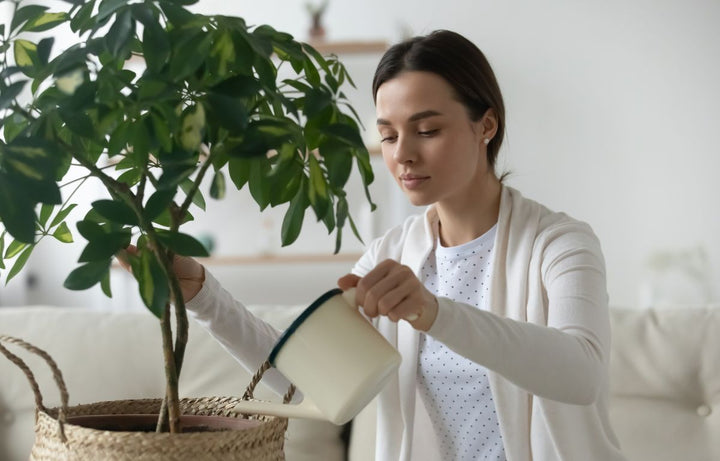
Watering Techniques To Keep Your House Plants Hydrated This Summer
Watering Techniques To Keep Your House Plants Hydrated This Summer
House plants not only add beauty and freshness to your living space but also require proper care to thrive. One of the most critical aspects of plant care is watering. However, there isn't a one-size-fits-all approach when it comes to watering indoor growing plants. Different plants have varying water requirements, and environmental factors play a significant role in determining how to water them.

Top-Down Watering
-
How to Use: With this method, you water your plants
directly from the top, pouring water onto the soil until it drains from the
bottom of the pot.
- Smaller water vessels or watering cans are recommended when top-down watering pots that do not have drainage holes. These allow greater control and reduce the chance of accidental overwatering.
- When to Use: Top-down watering suits most indoor plants, especially those in pots with drainage holes. It allows you to ensure even moisture distribution and helps flush out excess salts.
-
Why Use: Being the most simple and straightforward watering
technique, top-down watering mimics natural rainfall, which many plants
prefer.
- This is also a good watering technique for those who want complete control over their house plant care and maintenance.
- Problems & Solutions: Be careful not to overwater; monitor the soil's moisture level before each watering. If you notice water pooling on the surface or excessive runoff, adjust your watering frequency.
-
Popular Indoor Plants: Swiss Cheese (monstera deliciosa), Fiddle Leaf Fig (Ficus lyrata), and most other popular house plants.

Bottom-Up Watering
-
How to Use: Place the potted plant in a container or tray
filled with water. Allow the plant to absorb water through the pot's
drainage holes until the soil is moist. Discard any excess water after a few
hours. Bath soaking is the easiest form of bottom-up watering.
- It is also a convenient way of flushing extremely dry soil and ensuring pellet form fertiliser nutrients are able to penetrate the soil and reach the roots.
- When to Use: Bottom-up watering is ideal for plants sensitive to water on their leaves. It also helps prevent overwatering by allowing the plant to take up only the water it needs.
- Why Use: This watering technique ensures efficient water absorption through the roots. It also reduces the risk of fungal diseases on water-sensitive foliage, resulting in yellow or brown splotches that cannot be healed.
-
Problems & Solutions: Ensure the plant isn't left
sitting in standing water for an extended period. The water can become
stagnant leading to other fungal and bacterial issues like root rot.
- For optimal water absorption, make sure the soil has completely dried out before repeating this watering technique again.
- Popular Indoor Plants: African Violets (Streptocarpus sect), various Succulents and Cacti such as Aloe Vera and Jade Plant (Crassula ovata), as well as the Snake Plant (Sansevieria spp.).

Sub-Irrigation System
-
How to Use: A sub-irrigation system consists of a reservoir
beneath the plant's pot, connected by a wick or capillary mat. Water is
drawn up into the soil as needed, creating a self-watering setup great for
extended periods of neglect.
- If you do not want to purchase a self-watering pot, you can easily do this watering technique with two pots, placing one inside of the other. Make sure that the inner pot (the one that contains the plant) has drainage holes and is able to be suspended above the bottom of the larger one in order to create the water reservoir.
- When to Use: Sub-irrigation is perfect for forgetful or frequent travellers and plants that require consistently moist soil. It can be especially useful for large or heavy pots that are difficult to lift for traditional watering.
- Why Use: This method reduces the risk of overwatering, underwatering, and ensures consistent moisture levels for your plants.
- Problems & Solutions: Check the water level in the reservoir regularly to prevent drying out or flooding. Clean the system regularly to prevent mineral buildup and replace stagnant water which can lead to fungal and bacterial growth.
-
Popular Indoor Plants: Peace Lily (Spathiphyllum spp.), Chinese Evergreen (Aglaonema spp.), Dracaena (Dracaena spp.) and Devils Ivy (Epipremnum aureum).

Misting
- How to Use: Misting involves spraying a fine mist of water directly onto the plant's leaves and stems. Use a spray bottle filled with room-temperature water. This is an exceptionally good watering technique for terrariums that rely on high ambient humidity but do not require overly moist soil.
- When to Use: Misting is suitable for humidity-loving plants like orchids, ferns, and tropical species. It's also useful during dry winter months when indoor air tends to be very dry.
- Why Use: Misting helps raise humidity levels around the plant and can deter pests like spider mites. It also keeps dust off the leaves, allowing them to absorb more light.
-
Problems & Solutions: Avoid over-misting, as it can
lead to fungal issues. Use a fine mist and do it in the morning to allow the
plant to dry before nightfall.
- When watering house plants, other forms of watering may be needed in addition to misting. The fine water droplets may not be able to seep below the topsoil and reach the plant's roots.
- Popular Indoor Plants: Orchids (Orchidaceae), Ferns (Polypodiopsida), Bromeliads (Bromeliaceae family) and Nerve Plant (Fittonia spp.).
Choosing the right indoor plant watering technique is essential for the health and well-being of your green companions, but there is not just one watering solution. Each method has its advantages and is suited to different plant types, variations and situations. By understanding when and how to use these techniques, along with addressing common problems, you can ensure your indoor plants flourish and thrive. Remember, a well-hydrated plant is a happy plant!
